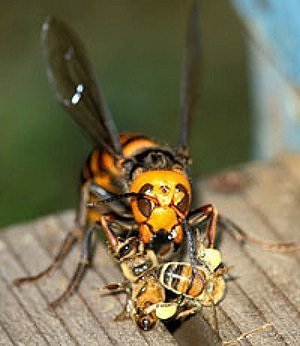Last week I disappeared off the edge of the blogosphere – rather like those unfortunate sailors did in the days before they discovered that the horizon wasn’t so much a precipice, more an ever-shifting focal point.
I was in London for the week, trying to accustom myself to the sound of cars and human beings and early-morning foxes. I got back yesterday via the white elephant that is Brive Dordogne Valley airport. Got back to my home, sweet home to discover that the willows are alive with hornets. What’s more, they’re the dreaded frelons asiatiques. This is bad news – just to compound the present misery of financial meltdown, environmental disintegration and the increasingly inevitable prospect of re-electing our diminutive president.

Day and night the activity in the willows sounds like a squadron of Lancaster bombers bound for Dresden. The inconceivably warm air is alive with their terrible drone. These creatures – with their angry orange ‘saddles’ – are fearsome. I watched a fascinating documentary about them some time ago. It was set in Japan, where they kill on average 50 or so human beings every year. Their sting is so virulent that you have to sever the affected limb with the nearest available blade to stop the venom reaching your heart. Well, possibly.
In Japan the indigenous bees have learned to contend with these aerial mass-murderers. A Buddhist monk explained how the colony lures the scouts into the hive and then swarms all over them so that they overheat and die before they can race off and tell their fellow killers that there’s a vulnerable hive at so-and-so coordinates. Alas, the poor naïve European honeybee – already facing extermination from pesticides and Traumatic Hive Disorder (or THD, as it’s known to the apian brotherhood) – is defenceless. The Asiatic hornet will just take them out in mid air or raid the hive and wipe out the entire colony just for the fun of it. They’re the etymological equivalent of Mexican drug gangs.
Until I came to France, I’d never encountered a hornet. I wouldn’t have known what one looked like. Then it was suddenly frelon this and frelon that, and pretty soon I was classing it with the equally dreadful viper in my almanac of French Fauna to Fear. I remember sitting up late one summer’s night, reading by lamplight near a window. There was a constant tapping at the glass and I looked up to see a frelon outside the size of a bullet, banging itself against our fragile farmhouse window, determined to get inside to kill le lecteur à table. It was like a scene from a horror story by Edgar Allen Poe. Reader, I was so perturbed that I took up my book in a cold sweat and retired at once to my bed.
Miles Davis lived for a while in Paris and he, too, must have heard tales of this intimidating insect, because he wrote a number called ‘Le Frelon Brun’ for his Filles de Kilimanjaro album. Whenever I give it a spin, I am transported back in time to that vengeful nocturnal kamikaze. The house defences held that evening, but sometimes they do get in – and it usually provokes a scene of panic and pandemonium. If I reach for the plastic fly-swatter, The Daughter is given to scream at me – not because she wants me to spare the life of the marauder, but because she fears that her father will miss his target and be stung unto death.
In fact, in recent times, I’ve learned that the common frelon is not aggressive. Unlike the wasp, it will not set out to sting you. However, when it has over-indulged itself at the vine, at the time of year when the juice of the grape is turning to alcohol, it is known to do reckless and headstrong things. So we take no chances in this house. Under the influence of my wife, we have renounced violence against intruders. Instead, we turn off all interior lights, turn on the outside light and open a door.
The trouble is, as I say, we are now faced with squadrons of frelons asiatiques, gorging themselves on whatever property they find on the leaves of the common willow. I can only assume it’s the equivalent of coca leaves for native South American Indians. They’re an unknown quantity at the best of times, but pepped up with vegetable amphetamines, who knows what they’re capable of?
For this reason, over the next few days I’m going to be sitting outside on a director’s chair with binoculars and Jonathon Franzen’s wonderful new novel Freedom. I’ll be lifting my eyes from the page to track their flight path to the wood. Apparently, they travel in a straight line, which makes the task a little easier. They nest, I’m told, in constructions that resemble ovoid paper lanterns, high up in a tree.
Either I call in an expert, who will then remove the nest at a fee commensurate with the considerable human risk involved. Or I go down to my neighbour’s house and ask if I can borrow the WW2 flame-thrower he salvaged from the Eastern Front. I appreciate that the trees are suffering enough from this current apocalyptic drought, but I’m honestly prepared to singe a few tops if it means eradicating the colony of frelons. Good for willows; good for bees.
In fact, I can already see the film. Sampo! ‘He… was just a little-known writer, who took up arms against a brutal foe to defend the departmental bee population – and in the process he won fame, glory and a Legion of Honour.’